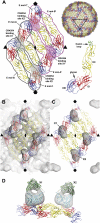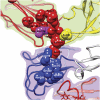Neutralization of West Nile virus by cross-linking of its surface proteins with Fab fragments of the human monoclonal antibody CR4354
- PMID: 20956322
- PMCID: PMC2973864
- DOI: 10.1073/pnas.1011036107
Neutralization of West Nile virus by cross-linking of its surface proteins with Fab fragments of the human monoclonal antibody CR4354
Abstract
Many flaviviruses are significant human pathogens, with the humoral immune response playing an essential role in restricting infection and disease. CR4354, a human monoclonal antibody isolated from a patient, neutralizes West Nile virus (WNV) infection at a postattachment stage in the viral life-cycle. Here, we determined the structure of WNV complexed with Fab fragments of CR4354 using cryoelectron microscopy. The outer glycoprotein shell of a mature WNV particle is formed by 30 rafts of three homodimers of the viral surface protein E. CR4354 binds to a discontinuous epitope formed by protein segments from two neighboring E molecules, but does not cause any detectable structural disturbance on the viral surface. The epitope occurs at two independent positions within an icosahedral asymmetric unit, resulting in 120 binding sites on the viral surface. The cross-linking of the six E monomers within one raft by four CR4354 Fab fragments suggests that the antibody neutralizes WNV by blocking the pH-induced rearrangement of the E protein required for virus fusion with the endosomal membrane.
Conflict of interest statement
The authors declare no conflict of interest.
Figures




Similar articles
-
West Nile virus in complex with the Fab fragment of a neutralizing monoclonal antibody.Proc Natl Acad Sci U S A. 2006 Aug 15;103(33):12400-4. doi: 10.1073/pnas.0603488103. Epub 2006 Aug 8. Proc Natl Acad Sci U S A. 2006. PMID: 16895988 Free PMC article.
-
Human monoclonal antibodies against West Nile virus induced by natural infection neutralize at a postattachment step.J Virol. 2009 Jul;83(13):6494-507. doi: 10.1128/JVI.00286-09. Epub 2009 Apr 22. J Virol. 2009. PMID: 19386704 Free PMC article.
-
Structural basis of West Nile virus neutralization by a therapeutic antibody.Nature. 2005 Sep 29;437(7059):764-9. doi: 10.1038/nature03956. Nature. 2005. PMID: 16193056 Free PMC article.
-
The structural immunology of antibody protection against West Nile virus.Immunol Rev. 2008 Oct;225:212-25. doi: 10.1111/j.1600-065X.2008.00676.x. Immunol Rev. 2008. PMID: 18837784 Free PMC article. Review.
-
The molecular basis of antibody-mediated neutralization of West Nile virus.Expert Opin Biol Ther. 2007 Jun;7(6):885-92. doi: 10.1517/14712598.7.6.885. Expert Opin Biol Ther. 2007. PMID: 17555373 Review.
Cited by
-
Development of a highly specific serodiagnostic ELISA for West Nile virus infection using subviral particles.Sci Rep. 2021 Apr 28;11(1):9213. doi: 10.1038/s41598-021-88777-5. Sci Rep. 2021. PMID: 33911132 Free PMC article.
-
Immunogenetic mechanisms driving norovirus GII.4 antigenic variation.PLoS Pathog. 2012;8(5):e1002705. doi: 10.1371/journal.ppat.1002705. Epub 2012 May 17. PLoS Pathog. 2012. PMID: 22615565 Free PMC article.
-
Structural Basis of Zika Virus-Specific Antibody Protection.Cell. 2016 Aug 11;166(4):1016-1027. doi: 10.1016/j.cell.2016.07.020. Epub 2016 Jul 27. Cell. 2016. PMID: 27475895 Free PMC article.
-
Characterization of a Prefusion-Specific Antibody That Recognizes a Quaternary, Cleavage-Dependent Epitope on the RSV Fusion Glycoprotein.PLoS Pathog. 2015 Jul 10;11(7):e1005035. doi: 10.1371/journal.ppat.1005035. eCollection 2015 Jul. PLoS Pathog. 2015. PMID: 26161532 Free PMC article.
-
Zika Virus: Immunity and Vaccine Development.Cell. 2016 Oct 20;167(3):625-631. doi: 10.1016/j.cell.2016.09.020. Epub 2016 Sep 29. Cell. 2016. PMID: 27693357 Free PMC article. Review.
References
Publication types
MeSH terms
Substances
Associated data
- Actions
- Actions
- Actions
- Actions
Grants and funding
LinkOut - more resources
Full Text Sources
Other Literature Sources

